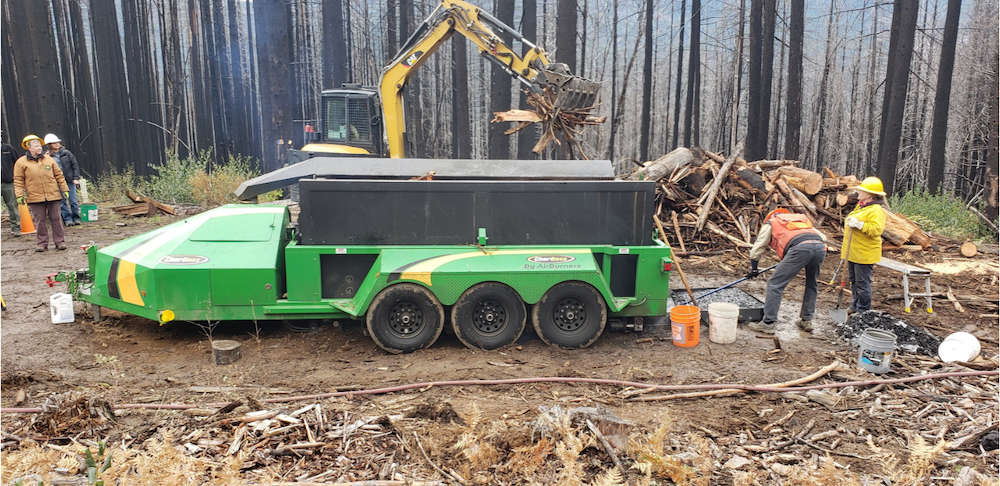| Attachment | Size |
|---|---|
| USFS_USBI-CharBoss-LCA-Report-FEB-29-2024-FINAL.pdf | 1.26 MB |
GHG life cycle assessment of CharBoss® biochar production and potential use for CDR certificate generation
Abstract
An ISO-compliant life cycle assessment (LCA) study was performed of the Air Burner Inc. CharBoss® pyrolyzing air curtain burner (Charboss). The LCA was set in the context of the Charboss processing forest fire reduction waste biomass into biochar. The purpose of the LCA is to quantify the carbon dioxide removal (CDR) certificate generation potential of the CharBoss use in this context.
The goal of the study was to carry out an attributional LCA study to calculate net emissions from biochar used as a carbon sink. This study is proof-of-concept focused and is compatible with LCA and greenhouse gas (GHG) accounting standards. The scope of this study is to calculate the net climate change impact of GHG emissions, in units of metric tons of carbon dioxide equivalent (MT CO2eq), associated with the feedstock processing and burning, and final use of the biochar produced.
All activity or foreground data is project-specific and originates from the CharBoss operations for United States Forest Service (FS) research projects on forest fire protection initiatives, covering all biochar production-related operations from biomass feedstock source to biochar utilization.
Through applying the puro.earth methodology to the activity data of the study, a carbon dioxide removal certificate CORC potential of -2.70 MT CO2eq per MT biochar produced was calculated. Similarly, it has been determined that this project has the potential to generate 2,403.81 MT CO2eq of CORC certificates of biochar during a 12-month period, through use of the CharBoss machine and subsequent application of the biochar to forest soils.
The study demonstrated that use of the CharBoss machine to process forest fire reduction harvest biomass into biochar has the potential to create marketable CDR certificates, while improving the sustainability of the National Forests under FS care.
Report prepared for USDA Forest Service and US Biochar Initiative
Project Lead: Deborah Page-Dumroese, PhD
Lead Author and LCA Practitioner: Gudmundur Johannesson
Lead GHG Analyst: Stephen Boles
Editor: Link Shumaker
Biosystems Engineering, PLLC.
101 Westview Dr
Carrboro, NC 27510-1501
https://www.gobiosystems.com
Rocky Mountain Research Station
1221 South Main Street
Moscow, ID 83843
https://www.fs.usda.gov/research/rmrs
US Biochar Initiative
5474 SW Arrow Wood Lane
Portland, OR 97225
https://biochar.org
ADDITIONAL NOTICE AND CLARIFICATION
Hello -
I am the editor of this document and the owner of Biosystems Engineering, PLLC.
Thanks to the USBI, the US Forest Service for commissioning this report and to Air Burners for creating the Charboss.
Also, thanks to all who have reviewed this document.
We appreciate your thoughtful review of our work and interest in this field.
We are a small shop and not able to respond to all questions, however this biochar.groups.io thread was brought to our attention so we want to provide the followings clarifications.
Re: Methane emissions:
- The methane emissions are incorporated into the Eproduction value.
- The methane emissions factor is called "EFcharboss" (last line item in Table 3 on page 18). Following that reference (hyperlink at footnote 8 on that page), scrolling to the bottom of the landing page and clicking on "Full Source Test Report" will take you to the referenced report.
- While we did not take part in this Stack Test Report, we reviewed it and consider it reliable for the purposes of our LCA. Page 10, Table 1-4 of the stack test report lists methane emissions as 0.688 lbs per ton of wood fuel.
- Our "EFcharboss" is a unit converted emissions factor which was used as part of the Eproduction calculation.
- While not stated explicitly in the report, the annual methanol emissions account for ~39.8 mt CO2e per year based on the operating assumptions in Table 3.
Re: Limitations of this LCA:
- This LCA has not gone through a formal third party peer-review process nor has it been verified by a third party auditor.
- This LCA has not been presented to nor accepted by any major registries. To our knowledge, its existence alone does not guarantee qualifications for carbon credits.
- This LCA was not a comparative study, therefore no comparative assertions should be made against other products or services.
Re: Figure 6 referenced in this thread:
- There are no avoidances included in this study.
- The colorful bars above the zero are emissions related to the production of biochar per dry ton of biochar; it was correctly pointed out that the methane emissions contribute to the magnitude of these emissions.
- The gray bar below zero is the amount of carbon calculated to be stored per try ton of biochar per the Puro "Estored" term method.
- The red "X" is the Estored term less the total emissions. We call this number the Carbon Removal Intensity.
- To calculate the total amount of theoretical CORCs, the Carbon Removal Intensity would be multiplied by the dry mass of biochar.
We hope this helps.
Kindly,
Link and Team
Biosystems Engineering, PLLC
www.gobiosystems.com